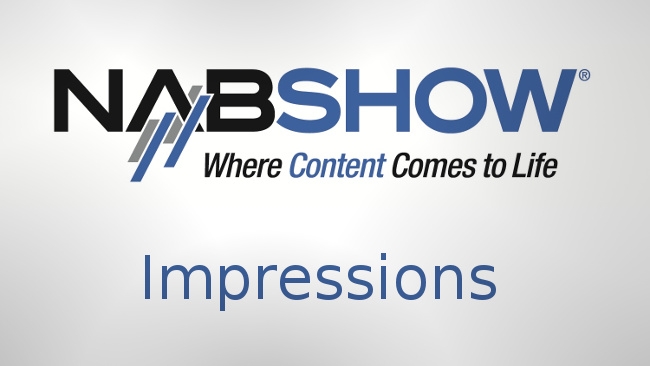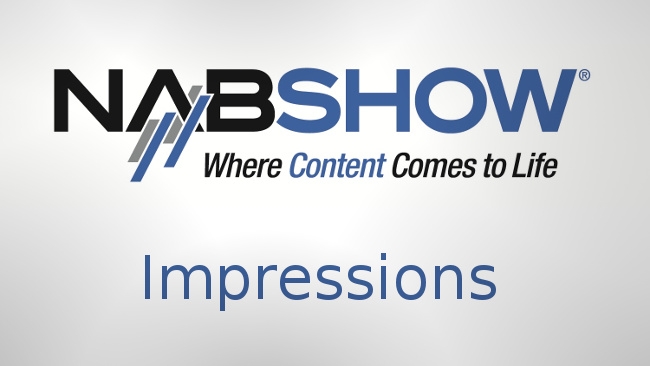
 Rakesh Malik's Impressions of NAB 2015
Rakesh Malik's Impressions of NAB 2015
After days of walking the convention floor, Rakesh Malik reflects on the new cameras that were featured at NAB 2015.
There were a lot of new cameras here at NAB. Some have been available for a few months (Cion), some are being unveiled for the first time here (Ursa Mini), and some seem to have sneaked in completely under the radar (JVC GY-LS300). 4K is all the rage, while RED is pushing 8K.
Most of the camera-related booths had studio setups with models and actors to photograph, the images displaying on large monitors overhead. The setups were good for getting a feel for the cameras' ergonomics, but not much else.
RED's booth was by far the most 'artsy' of all of the camera makers booths, while the JVC/Kenwood and Panasonic booths were pretty conservative by comparison. Canon was on the grandiose side. The studio setups in every booth look great in every camera. They're carefully lit and staged to ensure this, which is hardly surprising. Naturally, that means that the images on the monitors are largely identical in terms of how pretty they look.
I'm sure the various vendors want to convince you that buying their cameras will make you a better cinematographer because that sells cameras, but most of the booths don't do even an adequate job of showcasing what the cameras can do with a talented cinematographer in charge.
ARRI and Blackmagic didn't have much by way of footage for show. The ARRI booth was more like a catalog. RED, Sony and Canon had theaters showing footage. Canon showed some short films and documentaries filmed using the C300 MKII, which looked pretty good...but nothing about them stood out in today's market. Not because the films didn't look good, of course; on the contrary, they looked great. The imagery looked very good and, in the BTS segment, they talked about the benefits of the wide dynamic range of the C300 MKII and how they took advantage of it. Otherwise, I doubt that most people seeing the films would have noticed.
The understated JVC 4K camera was on display in the JVC/Kenwood booth, complete with a presentation showcasing its built-in live streaming feature. For ENG, this diminutive 4K camera seems like a winner, especially given its flexibility regarding lenses, thanks to having an MFT mount.
AJA had Cions all over the place, so that various companies could show them with their own products. They were certainly the nicest looking cameras in the show, but there was hardly any footage produced with them on display anywhere. In their own booth, AJA had several Cions set up to photograh the usual studio scene replete with models. AJA reps showed me a little bit of Cion footage on one of the computers they were using to demo some of their video processing hardware and software. The footage looked quite good, much better than what I've been seeing online so far. The cameras do have excellent handling, though they're fairly bulky, mostly to make room for the fan and vent. Cion runs pretty cool, it seems - almost as cool as a Sony CineAlta.
RED had a wonderful theater, complete with luxurious reclining chairs and tiered seating, as well as excellent sound. Outside of the NAB Futures, they were the only ones to include quality audio with their presentations.
Sony's booth was palatial. I've been in conventions that could have used that booth for the entire convention. The breadth of products Sony has to offer is astounding, far beyond cameras. Sony had new ingest and edit software to show, some stunning 8K footage in their theater, a device that adds live streaming to pretty much any of their cameras, an entire section devoted to live production (all in a truck) and a section for professional audio. One highlight was not actually in their theater, but rather in a black room lined with monitors. One of the new high- definition, 12-bit professional displays connected to Baselight showcased some of the 16-bit raw footage captured with Sony's F55 and F65 cameras, re-graded for high dynamic range. The detail and vibrancy of those images was exquisite. (Nearly the best in the show. Nearly.)
Even Kinefinity had some cameras to show and some KineMax footage on their Mac. Not the best presentation to be sure, but the footage looked great. Panasonic had a huge booth set up with a huge number of cameras, most of them for broadcast and studio use. They had a Varicam or two set up in the middle of the booth. They didn't have a theater, as far as I knew, but they had some interesting non-camera products on display, including a 21-inch ruggedized tablet running Windows.
The one theater that outdid Sony as far as simply showing stunning footage was in the Nab Futures booth, where NHK showed some footage from their 8K cameras in a theater with 22-channel sound. The seating was flat, but the sound and picture were breathtakingly vivid, filmed with an 8K super 35 format sensor. One of the NHK reps told me that with 8K raw, 40 minutes of footage consumed two terabytes.
And NHK is working on getting that level of quality set up for broadcast. They're far ahead of the US, where we're still broadcasting mere HD (and even that only barely), since our pitiful excuse for broadband isn't even up to the task of that antiquated standard.
So, what can one conclude regarding modern cinema and video cameras from NAB 2015?
There's no excuse for producing mediocre footage any longer. There are no technical constraints preventing even a tiny budget project from being stellar. You don't need an expensive camera to make a great movie and owning an expensive camera won't compensate for not having talent.
In the end, no one watching will know or care what you shot your film with. They'll care that it looks and sounds great, and that it has a great story. That's it.
Tags: Production


Comments